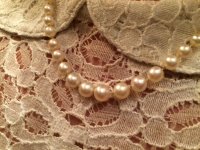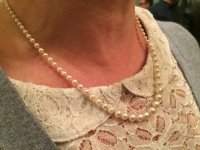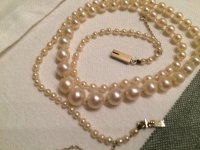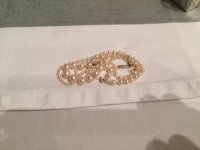FrenchPearl
Well-known member
- Joined
- Feb 9, 2013
- Messages
- 155
Hello all,
I have not posted in a long time, but visited the forums times to times. I'm still interested in pearls, but my obsession with them has somewhat slow down
However, I still keep my eyes open whenever I see pearls on my friends... So here is the story of this necklace.
Last December, I attended Christmas party, for which all the women (mostly French) wore pearls (required by the theme of the party) and many wore their family heirloom pearls. It was heaven !! I could easily identified, the akoyas, the fakes, the Chinese FWP etc... but there was one necklace that got me stumped.... the pearls glowed and... well, they talked to me.
So I started to question my friend, and she mentioned casually that they were natural pearls , not cultured, , an heirloom from her grandmother who was a well to do lady from the city of Lyon. (pearl purchased around 1910). Moreover, she said that the pearls were coming from a very reputable jewelry store, owned by relatives and still in the family. They had been very cautious over the generations, to have the necklace restrung only at this place.
I told her that the value of natural pearl necklace was quite high this day, hers seemed very well matched, and more round than off round, so she should get them certified. Intrigued, she sent the necklace back to her cousin jeweler in France, who confirmed it came from his store, was sold by his grandfather and was indeed of natural pearls . However, from different auctioneers / jewelers, she got estimates all over the place from 2000 euros to a 7 figures number (euros). On my side, during the party, I had ventured a 5 figures number ($), if it was confirmed natural.
With a certification (SSEFF or GIA) costing around $1000 (including shipping) , these estimates all over the place , she is now a little lost, wondering if it's still worth certifying.....
So, I know you don't like to give estimate, but I would love your recommendations to see if this necklace is worth sending to certification (Would the Swiss institute be OK vs GIA ?- ), and under the hypothesis it's natural, would love getting whatever range of amount you are comfortable with (or pm) , so she can make a more informed decision.
The necklace has 101 pearls, measures 38.5 cm (was longer, but she shortened it for her wedding), bigger pearl is 6.75 mm and smallest are 2.4 mm. Color is white, with no pink nor cream tint).
Pictures below where taken in December, with artificial light (at the party!), and I can't take any more since the necklace is now back in France.
And yes, I wore it and loved it !!
Thanks in advance for your feedback and recommendations
PS: also, if you think they might not be natural , please don't hesitate to say so. I just want to help my friend to be able to make a more informed decision.
Sophie aka FrenchPearl




I have not posted in a long time, but visited the forums times to times. I'm still interested in pearls, but my obsession with them has somewhat slow down
However, I still keep my eyes open whenever I see pearls on my friends... So here is the story of this necklace.
Last December, I attended Christmas party, for which all the women (mostly French) wore pearls (required by the theme of the party) and many wore their family heirloom pearls. It was heaven !! I could easily identified, the akoyas, the fakes, the Chinese FWP etc... but there was one necklace that got me stumped.... the pearls glowed and... well, they talked to me.
So I started to question my friend, and she mentioned casually that they were natural pearls , not cultured, , an heirloom from her grandmother who was a well to do lady from the city of Lyon. (pearl purchased around 1910). Moreover, she said that the pearls were coming from a very reputable jewelry store, owned by relatives and still in the family. They had been very cautious over the generations, to have the necklace restrung only at this place.
I told her that the value of natural pearl necklace was quite high this day, hers seemed very well matched, and more round than off round, so she should get them certified. Intrigued, she sent the necklace back to her cousin jeweler in France, who confirmed it came from his store, was sold by his grandfather and was indeed of natural pearls . However, from different auctioneers / jewelers, she got estimates all over the place from 2000 euros to a 7 figures number (euros). On my side, during the party, I had ventured a 5 figures number ($), if it was confirmed natural.
With a certification (SSEFF or GIA) costing around $1000 (including shipping) , these estimates all over the place , she is now a little lost, wondering if it's still worth certifying.....
So, I know you don't like to give estimate, but I would love your recommendations to see if this necklace is worth sending to certification (Would the Swiss institute be OK vs GIA ?- ), and under the hypothesis it's natural, would love getting whatever range of amount you are comfortable with (or pm) , so she can make a more informed decision.
The necklace has 101 pearls, measures 38.5 cm (was longer, but she shortened it for her wedding), bigger pearl is 6.75 mm and smallest are 2.4 mm. Color is white, with no pink nor cream tint).
Pictures below where taken in December, with artificial light (at the party!), and I can't take any more since the necklace is now back in France.
And yes, I wore it and loved it !!
Thanks in advance for your feedback and recommendations
PS: also, if you think they might not be natural , please don't hesitate to say so. I just want to help my friend to be able to make a more informed decision.
Sophie aka FrenchPearl




Last edited:
